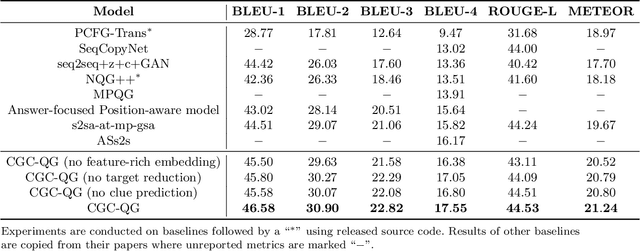Learning to Generate Questions by Learning What not to Generate
Paper and Code
Feb 27, 2019



Automatic question generation is an important technique that can improve the training of question answering, help chatbots to start or continue a conversation with humans, and provide assessment materials for educational purposes. Existing neural question generation models are not sufficient mainly due to their inability to properly model the process of how each word in the question is selected, i.e., whether repeating the given passage or being generated from a vocabulary. In this paper, we propose our Clue Guided Copy Network for Question Generation (CGC-QG), which is a sequence-to-sequence generative model with copying mechanism, yet employing a variety of novel components and techniques to boost the performance of question generation. In CGC-QG, we design a multi-task labeling strategy to identify whether a question word should be copied from the input passage or be generated instead, guiding the model to learn the accurate boundaries between copying and generation. Furthermore, our input passage encoder takes as input, among a diverse range of other features, the prediction made by a clue word predictor, which helps identify whether each word in the input passage is a potential clue to be copied into the target question. The clue word predictor is designed based on a novel application of Graph Convolutional Networks onto a syntactic dependency tree representation of each passage, thus being able to predict clue words only based on their context in the passage and their relative positions to the answer in the tree. We jointly train the clue prediction as well as question generation with multi-task learning and a number of practical strategies to reduce the complexity. Extensive evaluations show that our model significantly improves the performance of question generation and out-performs all previous state-of-the-art neural question generation models by a substantial margin.
 Add to Chrome
Add to Chrome Add to Firefox
Add to Firefox Add to Edge
Add to Edge